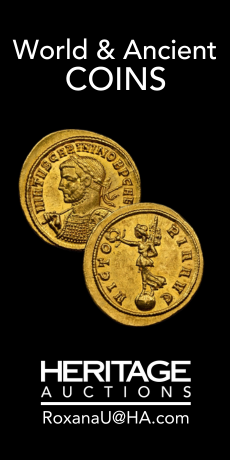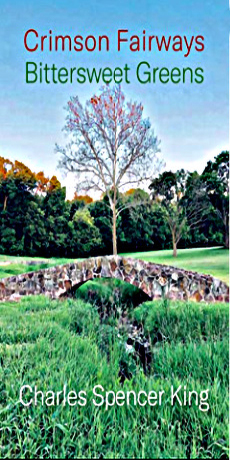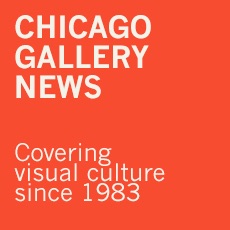By Minnie Marie Hayes
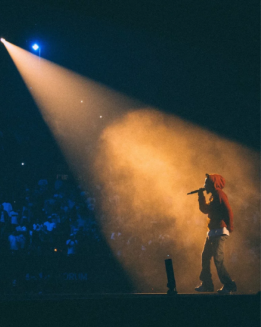
Kendrick Lamar
Suggesting after a recent Superbowl that Rihanna couldn’t carry a tune started me on this musical muse. So, I checked in on this year’s Superbowl to see if its superstar could carry a tune. Halftime showcases 2025 Grammy Award Winner, “Not Like Us.” Kendrick Lamar. Rapper Lamar twists and flips while he taps out a monologue message over a deep diastolic-systolic backbeat. No tune!
Tuneless is still music, according to the dictionary: “vocal, instrumental, or mechanical sounds having rhythm, melody, or harmony.” Music doesn’t need to have melody, or ‘tune.’ After all, Beethoven used the sound of birds and thunderstorms, Tuvan throat-singers sing the sound of running water or wind, French composer Jean-Philippe used the sound of clucking chickens in “La Poule,” Bob Dylan talks about writing “Wichita Lineman: “I just held two notes down… it’s (a) shivery, icy, almost like outer space kind of sound. Glen (Campbell) went crazy.”
I may prefer Mozart and Chopin, Whitney Houston and Johnny Cash, but history creates music reflecting feelings of its own moment, war, peace, love –Taylor Swift on bullying, Kendrick Lamar on owning and succeeding as the self you are.
As recently as the Victorian 19th Century, opera singers and classical music gave us our stars, say the lyric and dramatic tenor Enrico Caruso. But the Industrial Revolution pushed impoverished rural populations into shabby company-owned shanties thrown together in dark corners of cities. Populist music fits everyday lives, not orchestras and princesses jumping off castle ramparts.
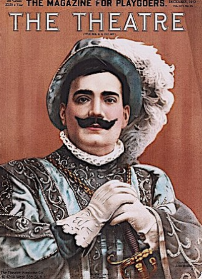 Enrico Caruso as Duke in The Theatre, 1912
Enrico Caruso as Duke in The Theatre, 1912
Vaudeville to the rescue: cheap theaters with singers, dancers, magicians, comedians, perhaps strippers. Vaudeville expressed the people on the streets, their rude gaiety, need for laughter and maybe sex. Vaudeville resounded with a favorite of mine, Ragtime, fast syncopated melodies dancing above a steady backbeat.
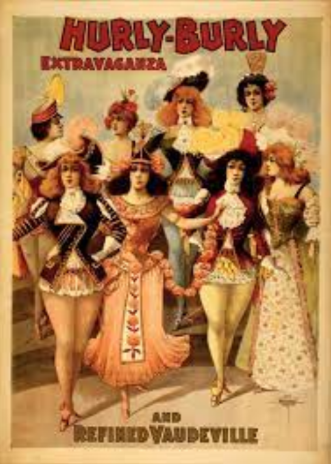
Up from the streets in New Orleans came jazz, an improvisational form with mainly instruments that jammed together musical styles of Louisiana’s own Caribbean port. Music from its humid alleys pulled people out into the cooler nights and streets alive with gospel, blues, African rhythms with syncopation, and old-time classics.
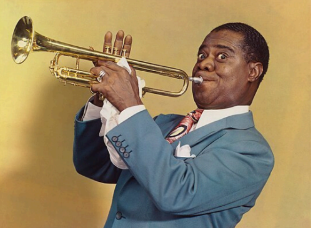
Louis Armstrong, 1953
Loose and freeform, Louis Armstrong— perhaps the greatest of all jazz soloists— electrified a generation with Scat, nonsense syllables imitating an instrument. UTube has a clip of Ella Fitzgerald sounding exactly like a piano. No difference. Musicians tuned their instruments to Ella’s perfect pitch.
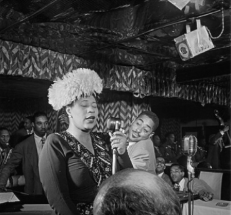
Ella Fitzgerald with Dizzy Gillepie, Ray Brown, Milt
Jackson and Timme Rosenkrantz in New York City, 1947
Jazz flowed north, up the Mississippi, with post-Civil War northward migration. In Chicago it grew underground during Prohibition and thrived in speakeasies where it combined ragtime and black spirituals. Then electric guitar intensified music, producing a louder volume that cut through noise in bars and nightclubs. Chicago musicians such as Muddy Waters used electrified guitars to blend classic Southern into Chicago Blues and blues bars played late into night until blending with the early morning street thumping, clatter and hawking along Maxwell Street, one of the largest open-air markets in the nation.

Open air Blues on Maxwell Street market, 1950s
But by the 40s, R&B, Rhythm and Blues, seeped into the mainstream. Of note, R&B records got classified as “race music,” their sales reported separately from ‘White music’ records.
But nothing stays the same. Radio, revolutionized music. Emerging musical forms did keep the classical backbeat, ragtime morphed into dance and Big Band music made stars of Duke Ellington and Glenn Miller. Homes all over the country tuned in nightly to hear Big Band music while Irving Berlin, Cole Porter and George Gershwin created mainstream folk, relating personal stories of real people. In a multi-cultural country, music introduced us to each other.
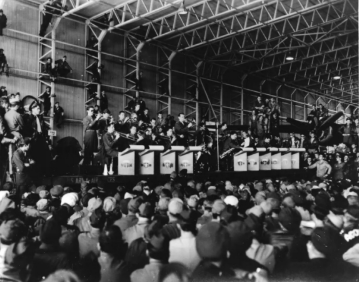
6Aug44-Glen Miller’s Army Air Forces Band
Radio tuned us into two world wars and a Great Depression. Then teenagers with money, weary of both war and Depression, welcomed a new type of sensation, sentimental crooners Bing Crosby and Frank Sinatra. Teenagers ‘swarmed,’ a new phenomenon itself. Massive performances became chaotic, erupted by screaming and swooning. (How do you swoon? I’ve always wondered.) Radio’s weekly ‘Hit Parade,” broadcast nationally, catapulted sales of records and tapes.
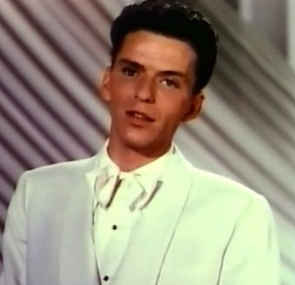
Frank Sinatra
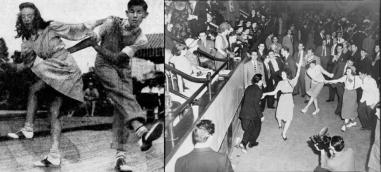
Jitterbugging
Technology post-WWII taught musicians to overdub, blending live performance with recorded background. Wild showmen like Jerry Lee Lewis became country music pioneers. Then, in 1954, an unknown kid from Memphis startled the South with an electric guitar and he converted 1950s music into country, folk, bluegrass and blues.
Elvis Presley, with his charismatic stage presence and whirly-gig hips, ushered in musical excitement that rendered crooners obsolete. Interesting that he couldn’t read or write music but could hear and play back a song after only one listen. His impressive male vocal range of two and a half octaves included near-perfect pitch, although he’d sing off-key when he thought it improved a song. “His off-key notes became a
separate art form.” Star by any definition, Presley combined southern music from many cultures into a new music, “Rock and Roll.”
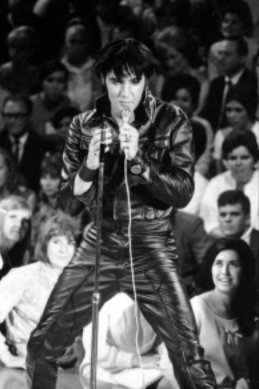
Elvis
Elvis Presley, with his charismatic stage presence and whirly-gig hips, ushered in musical excitement that rendered crooners obsolete. Interesting that he couldn’t read or write music but could hear and play back a song after only one listen. His impressive male vocal range of two and a half octaves included near-perfect pitch, although he’d sing off-key when he thought it improved a song. “His off-key notes became a separate art form.” Star by any definition, Presley combined southern music from many cultures into a new music, “Rock and Roll.”
While Elvis shocked on TV, budding stars still sang Tin Pan Alley and old classics in the basement cafés of New York and Chicago. I then dated an impecunious young law student, and he’d take us into Mister Kelly’s where we’d sit on stools at the bar for two hours after a show closed then be in place to watch the next show—without paying a cover.
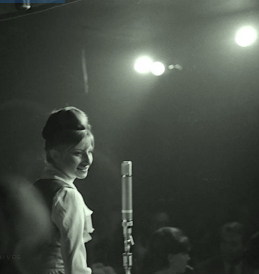
Barbra
One night, lights dimmed to a black room, and a quiet voice came out of the dark. Under a brightening spotlight, a half-grown sliver of a girl in silver lamé started softly, “Secondhand clothes…” then coming on stronger),” I’m wearing secondhand clothes.” It made one shiver. There was a barely known, Barbra, the girl from Brooklyn with a voice some called ‘borscht belt’. Streisand sang with humor but real affection about life in a tight family culture, orthodox and ancient.
Right behind Streisand at Mr. Kelly’s might come comedian Mort Saul with cutting political satire; across the street at the Gate of Horn Lenny Bruce set about to offend anyone he who came to be offended. Lena Horn sang in a basement café down Rush Street, Mel Tormé and Edie Adams in another.
Chicago was so young–only seventy-five or so years since the Chicago Fire. The explosion of musical innovation matched the literary streets of Chicago where walked Saul Bellow, Ernest Hemingway, Studs Terkel –all cutting their literary teeth on the new city’s shoulder-to- shoulder cultures.
Meanwhile, John Kennedy and the unpopular Vietnam war pushed draft-aged men to escape war by crossing the border and becoming Canadian citizens. Bloody Civil Rights protests split the country. It was the proverbial “worst of times, best of times,” throbbing with both fear and ambition. Loosened boundaries opened a door to Motown, R&B and Protest music, all of which opened the door to the British
invasion … The Beatles!
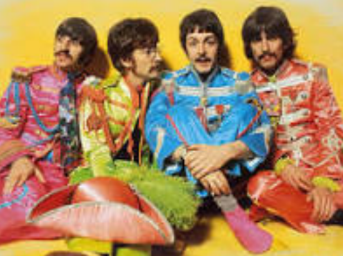
Perhaps the most innovative musical sensation of all time, the Liverpool quartet combined Skiffle— music played on rudimentary home-made instruments—with piano, harmonica, violin, drums, banjo, sitar, tambura. They created their own music, had fun with Doo-wop (parts of the melody sung without instruments, and changed the way people would interact with music and musicians forever.
The Beatles, four Liverpool kids, couldn’t read or write a note of music. Paul McCartney called written music ‘dots on a page.’ The Beatles would assemble in a studio with a sheet of chords from George Harrison and start playing around with them—fitting in modal inflections, blue notes, pre-recorded sounds and electronic distortion, non-pop instruments and stepwise harmonic progressions. Literature classes, as did mine, still teach Beatles lyrics as poetry. The combined musical talent of the untutored four, with soul-probing lyrics, broke like a tsunami over a Vietnam-angry generation of draftable teenagers and strongly influenced the hippie movement.
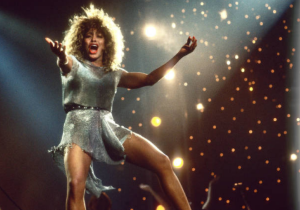
Tina Turner
Relief at ending the war in Vietnam, and struggling through the 70s oil shock inflation, led to an emotional escapism and became a decade that really knew how to party: dancing, disco, Saturday Night Fever and the wildly flamboyant Tina Turner, although perhaps Turner’s singing didn’t count: Just her flare and … legs! My nephew loved to lie in bed at night and watch Tina Turner on TV, telling his wife to turn off the sound.
Post-war, the 80s rejected the 70s unsprung partying and disowned the ‘establishment’ with Hip Hop, break dancing, graffiti art, and rapping with sludgy, distorted guitar, then Michael Jackson with his high tenor, perfect pitch, and moonwalk.
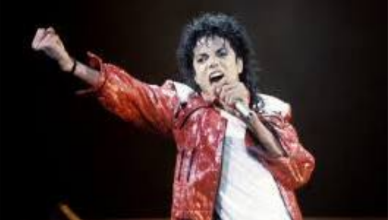
Michael Jackson
Whitney Houston cut her teeth on these churning musical styles: “I had the singing in me, but she (her mother Cissy Houston) taught me how — and she taught me through gospel.” Houston’s incredible control combined the contributing influences around her with inflection and a phrasing called melisma. In “I Will Always Love You”, an early “I” takes nearly twenty seconds to sing. In those seconds the former gospel-singer packs in a descending, then ascending series of different notes into one syllable. The technique is repeated throughout the song, noticeably on every “I” and “you”, her powerful voice finally hanging in the air for an aching-long fifty seconds. Her orchestration of Dolly Parton’s love song needed Kevin Costner’s demand in “The Bodyguard” for producers to allow Whitney Houston to sing it her way, starting A Capello, building and rising slowly to release so high it makes one’s head buzz. Dolly Parton, who wrote the song, heard Houston while driving and had to pull off the road to sit still, overwhelmed.
So then Rihanna. How did she become a star?
She does ride on an apogee of globalism. An immigrant from Barbados who grew into music from cultures surrounding her in that British plantation island, her first hit came during the heightened post-war global tensions after 9/11. She uses her cultural fluidity, often singing in the local Jamaican patois spoken in Barbados. Combining her West African-inflected English with Caribbean rhythms—reggae, dance-pop, hip-hop and American R&B—her low, alto voice can sound raw to me, like a street vendor hawking, someone stridently surviving in the
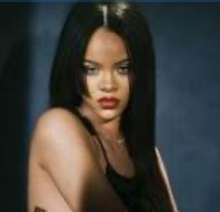
Rihanna
thick of things—exactly as she wants it to. She says that her success isn’t only about her; but about Barbados, her family, her fans and “women,
about black women.” Rihanna has become a pop music vanguard, an opinion-leader. Her voice has brought new tones and sounds to music; her videos have changed fashion.
All 3 sopranos, Rihanna, Houston and Taylor Swift, thrill followers with high notes and wide octave ranges. I still think Rihanna often slips off key. However, all without exception brought something new and unexpected to the inseparability of history and music. My granddaughters, in their own generation, caught on early that Rihanna gave birth to their own moment, to new music being born.
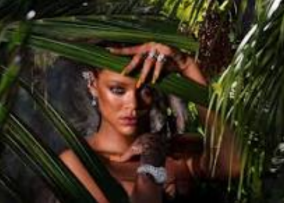
I finished this essay, and that evening asked friends what makes a great singer? Victoria immediately said ‘personality!’ Adam chipped in, “People just want to dance.”
Looks like I got it wrong. Voice doesn’t matter? At least that explains Leonard Cohen.
So am I unfair to Rihanna?
OK. I believe in humility. I do. My granddaughters are of their own time. And I admit, Rihanna’s vibrato rolls and makes her a sex symbol, if not an Ella Fitzgerald. It bothers me, but not Rihanna, if she hits the wrong pitch, or slips off-key. She intends that what she sings sounds natural and straight from her people thronging Caribbean markets.
Shucks. I’ll give her a break. Rihanna’s not so bad. She still, if the music goes there, goes with it, grabbing and hanging on. Reaching for the stars.



